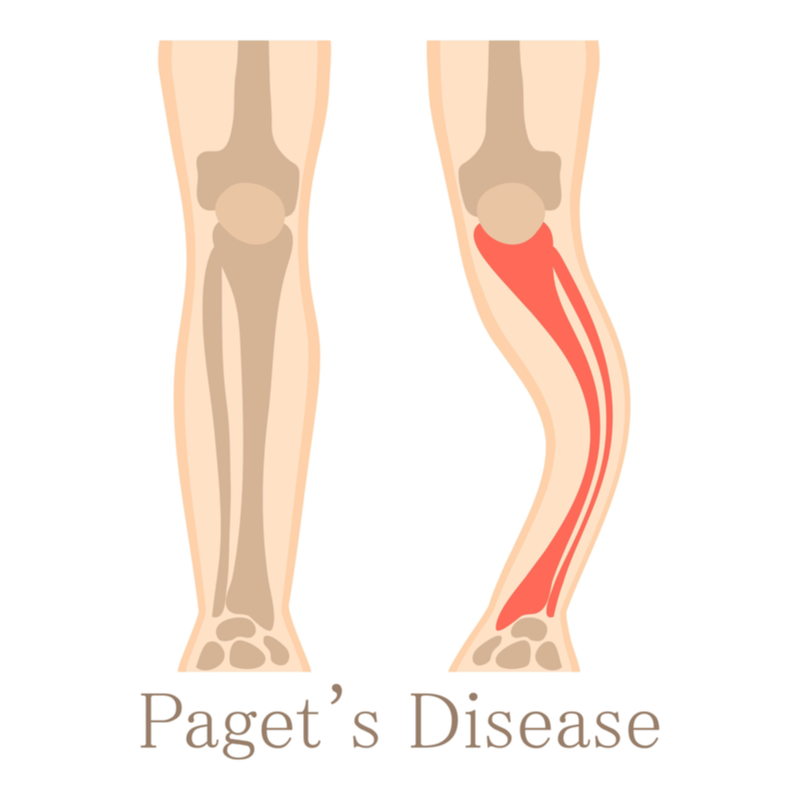
What is Paget's disease?
Paget's disease is a disease of the bones. In some places, deformed and thickened bones develop. The exact cause of the disease is still completely unknown, but it is possible that a viral infection and genetic factors play a role in the development of the disease. Paget's disease is named after its discoverer, the British surgeon Sir James Paget, who first discovered it in 1877 . Paget's disease unbalances the breakdown and formation of the bones in the body, resulting in the development of instability and deformation of the skeleton. This is caused by pathological changes in the cells that are responsible for bone resorption . Paget's disease usually does not appear until the age of 40 and the majority of patients remain symptom- and symptom-free, which is why the disease can often remain undetected for the rest of their lives .
What are the symptoms of Paget's disease?
Even if the disease does not show any symptoms in most cases, the following can indicate Paget's disease:
- Pain in the bones, joints and muscles,
- Deformities and misalignments of bones,
- Wear and tear of joints,
- Bone fractures,
- Nerve damage,
- Hearing loss.
How is Paget's disease diagnosed?
Since Paget's disease usually does not cause any symptoms, most sufferers do not see a doctor. This is why the diagnosis of Paget's disease is mostly made by chance, for example, when blood values change or when there are changes in the X-ray picture, which was taken for a completely different reason .
Paget's disease is therefore diagnosed in several steps.
The medical history
First of all, the doctor will take the patient's medical history. Based on the symptoms that the patient describes, the doctor can already roughly estimate whether Paget's disease can be the cause. As a rule, the doctor will ask about the following:
- Whether, and if so, where the pain occurred,
- Whether this pain only occurs in a certain place, such as the back, the joints or the head,
- How long this pain has been present,
- Whether the temperature of the skin over the area is elevated,
- Whether the circumference of the head has changed,
- Whether complaints such as numbness, paralysis, visual or auditory disturbances have occurred.
The physical examination
The doctor will palpate the affected area to get an idea of the intensity of the pain. He will also check whether there are contractures, shortenings or even malpositions such as deformations . By comparing the right and left sides, the doctor will be able to see whether muscle mass has receded. He may check the gait pattern to see if it is fluid or limping. He will also perform some tests on the joint functions and check the range of motion.
The laboratory test
In patients suffering from Paget's disease, the blood test usually shows an increased concentration of alkaline phosphatase. This is a clear indication that increased activity of the osteoblasts, the bone-building cells, is underway. The activity of the osteoclasts, the cells that break down bone, can also be determined . In addition, the urine is checked for the amount of deoxypyridinoline. This substance is released when the bones are broken down .
X-rays and scintigraphy
To be able to diagnose Paget's disease with certainty , an X-ray examination is essential. The disease progresses in three phases, which are visible in the X-ray:
- In the first phase, bone resorption is visible, i.e. osteolysis.
- In the second phase, a picture of bone resorption and areas of increased bone density, osteosclerosis, can be seen.
- In the third phase, almost only areas with increased bone density and distortions and also deformations of the affected bones are visible.
Scintigraphy is used to look for
even more lesions of the bones. This examination is
much more sensitive than the X-ray and can therefore make even more
affected bone areas visible.
How is Paget's disease treated?
The treatment goals for Paget's disease are to relieve pain and to stop bone remodelling. Here, the drug bisphosphonate and calacitonin are often used to inhibit the breakdown of the bone. Paracetamol is usually given to relieve the pain. If severe arthrosis or fractures of the femur occur, surgical intervention must be considered. If neurological symptoms occur, such as gait disturbances or paralysis, which occur due to nerve compression, surgery of the spine is inevitable.
What are the complications of Paget's disease?
Due to the disease, the risk of developing bone cancer, osteocarcinoma is significantly increased. Although less than one percent of people with Paget's disease are affected, it is still important to have a medical examination and check-up at regular intervals. It is advisable to have the blood values checked regularly at . If the symptoms worsen during the course of the disease , it may make sense to have another x-ray examination to rule out other diseases .
What is the prognosis for Paget's disease?
If no bone cancer forms during the course of the disease, the prognosis for those affected is very good. In most cases, there are no symptoms and life expectancy is usually not shortened in patients with Paget's disease. Thanks to drug therapy, it is possible for patients suffering from Paget's disease to lead a relatively normal everyday life, despite more or less pronounced limitations. Regular follow-up with the appropriate doctor is important for a good prognosis.
